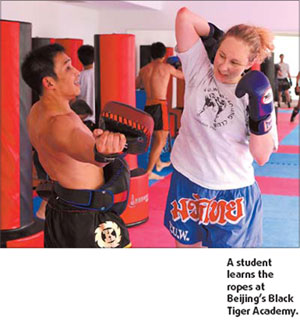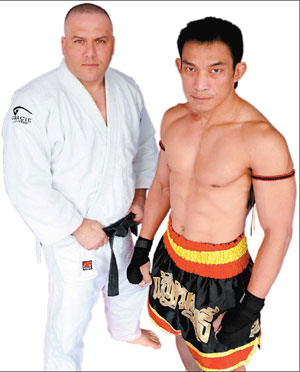
CHINA DAILY / Page 18
A one-two punch
By Jeremy Hartley for China Daily
Updated: 2007-09-13 07:1
The two fighters circle one another, testing the distance with jabs and low-slung kicks, aimed at the knee and ribs. Without warning, one combatant charges, and in a flurry of fists and grasping hands, the two grapple their way toward the choke or excruciating arm-bar that will end the fight.
 Within seconds one is on his back, the other sitting astride him aiming punches at his nose and mouth. When they finally break, the fighter on the ground slowly rolls to his knees.
Within seconds one is on his back, the other sitting astride him aiming punches at his nose and mouth. When they finally break, the fighter on the ground slowly rolls to his knees.
"If he gets up like that again, kick him in the face," says Professor Chet Quint, a bull-necked black belt in Brazilian Ju Jitsu (BJJ).
The combatants chuckle as they catch their breath.
"I'm serious," adds Quint. "He knows better than to get up like that."
Scenes like this are common at Beijing's Black Tiger Academy, home to what its owners describe as China's most authentic experiences with BJJ, muay Thai (Thai boxing) and Mixed Martial Arts, the system that blends the two together. Every night and weekend at the school's ninth floor space in Jianwai SOHO, paying students from China and beyond learn the world's most bone-cracking fighting styles. It is a testament to the interest in these arts that Black Tiger Academy draws such a crowd, even in the country with arguably the world's most rich and celebrated martial arts culture. Think of it as all the promise of globalization with an elbow to the throat.
 Black Tiger Academy is the brainchild of Quint, a "martial arts junkie" from the United States, and Vincent Soberano, a former World Welterweight Champion Thai boxer from the Philippines. Before opening Black Tiger, the two had traveled the globe, perfecting their respective arts on the wrestling mat and in the ring. A chance encounter in Beijing in 2005 revealed the two to be kindred spirits, each intent on sharing his art, and both open to the possibilities of combining them.
Black Tiger Academy is the brainchild of Quint, a "martial arts junkie" from the United States, and Vincent Soberano, a former World Welterweight Champion Thai boxer from the Philippines. Before opening Black Tiger, the two had traveled the globe, perfecting their respective arts on the wrestling mat and in the ring. A chance encounter in Beijing in 2005 revealed the two to be kindred spirits, each intent on sharing his art, and both open to the possibilities of combining them.
Muay Thai and BJJ might seem like strange bedfellows. Muay Thai is a centuries-old kickboxing style that incorporates knee and elbow strikes. Though Thai boxers do learn grappling techniques, their primary focus is toe-to-toe brawling. It was developed by Thai kings and used in wars throughout history. Today, muay Thai is a wildly popular sport, both in Thailand and abroad.
BJJ is a comparatively modern - and aggressive - adaptation of Japanese Judo that was developed in Brazil by the legendary Gracie family, and which grabbed the world's attention in the 1990s when the diminutive Royce Gracie won several Ultimate Fighting Championships using the art. Its language is one of arm-bars, chokes and other submission holds.
"Eventually you are going to end up on the ground with us, and you will lose," Quint says.
The two styles are recognized for the efficiency with which their practitioners dispatch opponents. Both are steeped in legend, from tales of Thailand's royal family learning to box to the rise of the Gracie fighters. Combined, these arts have reshaped the way martial artists fight - the slashing kicks and elbows of muay Thai are mixed with the apparently unstoppable ground fighting techniques of BJJ in a Frankenstein's monster that is equal parts violence and tradition.
Soberano got his first taste of muay Thai 32 years ago, when, at the age of 10 he saw a professional fight at Bangkok's Lumpini stadium.
"I saw these guys soccer kick each other's heads off," Soberano recalls.
He was hooked. He started training at a camp in a former prize-fighter's garage the next day, and had his first real fight at the age of 13. He later moved to the United States, where he would go on to become the World Welterweight Champion, with 64 professional fights under his belt.
Inspired to share his skills, he opened his first Black Tiger Academy in San Diego in 1991.
A software engineer by trade, Soberano moved to Beijing in 2004 to run an outsourcing office and then started his own software consulting company in 2005. However, the lure of the ring never faded. Tired of shadowboxing in his office, Soberano looked for a place to teach the art he had practiced since his boyhood. That same year he met Professor Chet Quint.
"I didn't really have any plans to teach until I met Chet," he says. "It was a great opportunity to present the two most powerful fighting systems in the world."
Quint is the only BJJ black belt teaching the art in China. His own love affair with martial arts started at the age of 13 in Miami, Florida, where he trained in everything from Tae Kwon Do to stick-fighting. After stints as a bouncer and police officer, Quint picked up on stories of a tough ground-fighting new style from Brazil. A video entitled Gracie In Action convinced him that he had a hole in his repertoire.
He started training under Professor Pedro Sauer, one of the world's most famous BJJ teachers, in Salt Lake City, Utah, in 1996. Sauer, along with Gracie brothers Rickson, Rorion and Royce, was part of the first wave of BJJ teachers to travel abroad.
In 2004, Quint moved to Brazil to train and met an Australian student who encouraged him to come to Beijing. Quint decided to take him up on the offer.
What he found surprised him. Many of the young Chinese people he met were more interested in Western culture than their own traditions, while many of the expats were having a hard time finding a Chinese martial art that suited their needs.
"Chinese people had no idea what Jiu Jitsu was," he says. "I was naive because when I came out here I thought I would be able to tap into this huge martial culture."
Soberano agrees that people here are wary of non-Chinese martial arts.
"We're not the first choice. We're not even the second choice. But eventually people come here looking for something more realistic," he says.
Tamara Shefa, 25, from Tel Aviv, Israel, is one such student. She had studied Chinese at home and came to Beijing for a deeper experience. She was also looking for a way to continue her kickboxing hobby, but struggled to find a place to study kung fu.
"And Tai Chi is too slow for me," she says.
Black Tiger proved to be a fortuitous discovery. "I've never had physical contact. I've only ever hit the bags and the air," she says, wrapping her wrists before a muay Thai class.
Quint says some of the school's students come for the fitness and some for the self-defense. Some even come hoping to fight professionally, which Quint says could take 10 years of training.
Bush Shen, 22, a Chinese American student at Peking University, had been studying muay Thai for one year and a half before coming to China and spent his Spring Festival holiday at a boxing camp in Thailand.
"I see it as the most practical form of self-defense," he says, adding that the health advantages were also important.
Stress-relief is one of the reasons Brandon Cristiano, 36, an American chef from Washington DC, comes to Black Tiger.
"I have a little too much energy for one person," he says. "I spend most of my free time here at the gym."
"To train with people of their caliber and experience you can't ask for a better thing in a school," he adds.
Whatever people's reasons for coming, they are in for a tough workout. And, as Quint notes, the experience of fighting can be transformational.
"You can take that knowledge, that lineage, with you wherever you go in the world," he says.
http://www.chinadaily.com.cn/cndy/2007-09/13/content_6102108.htm
(China Daily 09/13/2007 page18)




No comments:
Post a Comment